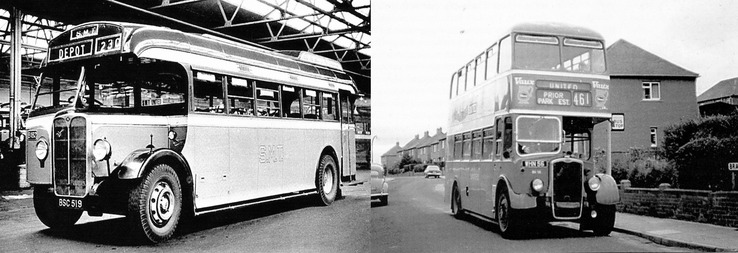In the beginning
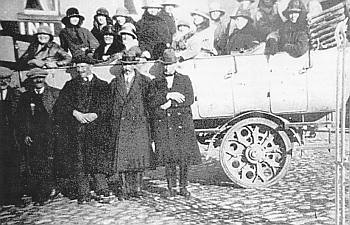
Cuthbertson’s of Seahouses charabanc on an outing from Beadnell in the early 1920s. © Fred Kennington.
In London in 1829 George Shillibeer decided to try running a big horse-drawn coach available to anybody who wanted to travel at individual fares, at a time when only the wealthy could travel thus. Shillibeer’s venture didn’t last, but his name for it did: the Omnibus (Latin: “for all”). In the second half of the 19th century these vehicles appeared in Berwick and adverts announced that “omnibuses meet all trains” – for visitors staying at the King’s Arms and the Red Lion. (For more about George Shillibeer and the early history of the bus, see this article [PDF]).
By the 1890s the internal combustion engine had arrived and was transforming the transport business, and early bus manufacturers included Scott-Stirling, Milnes-Daimler, Maudslay, Straker-Squire, Dennis, and Leyland. Because Berwick had good rail connections the need for bus transport was not immediately perceived locally, though some services did begin in the Borders. In Seahouses Stanley Cuthbertson bought two motor wagonettes in 1905 and 1907 to run between Bamburgh and Seahouses Station to connect with trains. (Their registrations were X 482 and X 905; X was the earliest registration mark for Northumberland.)
Berwick’s first bus
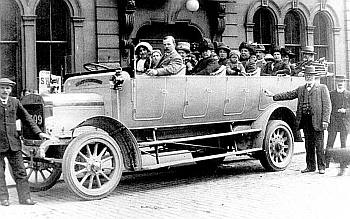
Adam Logan (right) and John Logan (left), owners of the Berwick-upon-Tweed Motor Car Company Ltd, with their comfortably fitted out Commer charabanc, registration number KS99 outside the old Corn Exchange building in Sandgate, on its first outing to Bamburgh in 1913. The well-heeled paid passengers four shillings for the outing, the equivalent of a week’s rent for many at the time. © Fred Kennington.
By 1906 buses on early trial services would have been seen passing through the town, but it was 1913 when a group of local businessmen, led by Adam Logan, set up the Berwick Upon Tweed Motor Car Co. Ltd. Their first bus was a Commer charabanc (reg. KS 99) and Adam Logan himself went to Luton to collect it and drove the bus back – at a maximum speed of 12 mph. It went straight into service with a trip to Norham and Ladykirk. A full programme of day trips followed (Chain Bridge 1/-; North Berwick 5/-, beyond the means of many). They also ran a service between Berwick and Spittal.
The subsequent history of the company and its bus is unknown, but with the outbreak of World War 1 in 1914, only very essential bus services were operated. Drivers went into the Forces, and buses were requisitioned for military use.
Post WW1
After the 1914-1918 war, the Government found itself with a surplus of lorries, which were capable of being fitted with rudimentary bodywork to carry passengers. Men who were leaving the army with gratuities saw opportunities to set up in business, and a wave of ruthless competition in the bus industry continued through the 1920s. In Berwick, James Whillis, a pre-war haulage contractor, bought a charabanc body to attach to one of his lorries. On Friday evening Whillis and his wife would unbolt a lorry body and fit the charabanc body, and then they ran local Sunday afternoon trips and took private parties; on Sunday evening the process was reversed. Whillis bought three charabancs and a small Chevrolet bus to expand his business, but he never operated bus services as such; the charabancs were withdrawn by 1930 and the Chevrolet in 1935, after which he concentrated on his haulage business.
Berwick rivals
If you wanted to run a bus service then you applied to the local council for permission, some of whom were stricter than others, and few records were kept. Berwick issued licences for buses and for drivers and conductors, though records are patchy.
In the 1920s, three main bus operators ran services to and from Berwick:
THOMPSON Brothers. Robert, Andrew and Hector Thompson had set up a haulage business in 1912. From the early 1920s (possibly 1920), Thompson Brothers ran their first bus service between Berwick and Spittal via the Old Bridge (the New Bridge didn’t open until 1928). The venture was a success and they bought more buses, running also to Scremerston from 1923, Ford, Branxton and a summer service to Philadelphia (the one better known as Cocklawburn!).
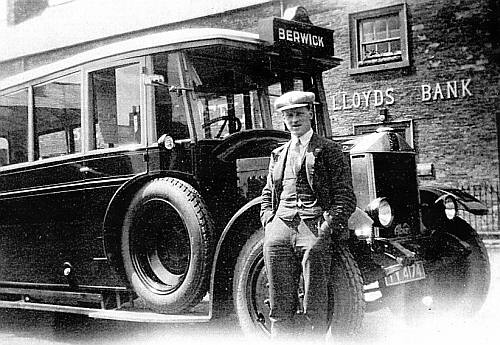
Thompson’s Albion PJ26, TY 4174, new in 1928, stands at Belford. The driver is Norman Inglis. © Fred Kennington.
SPOWART Brothers. Robert and Philip Spowart had bought the Berwick-Spittal ferry in 1907, and until 1922 it was the only means of travelling between the two places. They soon realised that Thompson’s bus, going the length of Spittal and along to Sandgate in Berwick, was more convenient than their ferry. They began their Berwick-Spittal bus service in March 1923.
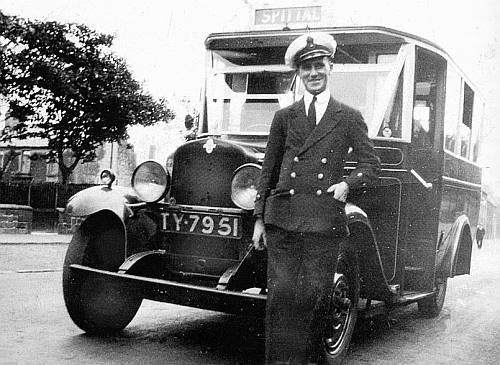
A Chevrolet LQ, 14-seater, registration number TY 7951, new to Spowart Brothers in 1930, takes a break at Spittal terminus. © Fred Kennington.
JOHN YOUNG, based at Norham, bought his first lorry/bus in 1923 and his first ‘proper’ bus in 1924. He chose to run between Norham and Berwick and Berwick to Wooler.
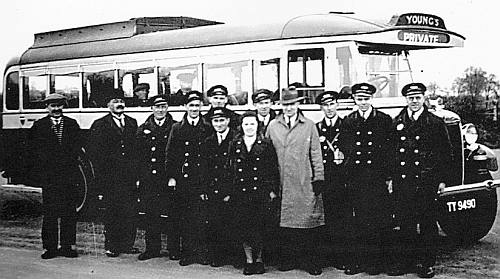
John W Young’s Gilford 1680T, registration number TY 9490, taken at Norham c. 1932. From the right: Jimmy Todd, Ralph Swan, Aaron Oliver, John Young, J. Hume, Janet Jobson, Carmichael, unknown, Andy Murray, J. Welsh, unknown, unknown. The staff are shown wearing a uniform, which was unusual for a small operator at the time. © Fred Kennington.
The Thompsons and the Spowarts were in direct competition with each other on the Spittal service, and they and their staffs were soon ‘at open war’. Through the 1920s Berwick Council tried to maintain some order and to enforce timetables with equality between them. At busy times there could be a bus every five minutes. Philip Spowart became a member of the Town Council, and later Mayor of Berwick. John Young was not involved in any of this competition and operated to a high standard.
A MYSTERY BUS. The case of a ‘mystery’ double decker in Berwick in the 1920s and additional information on local operators and services in this period can be found in this PDF document.
Other independent operators also appeared around this time.
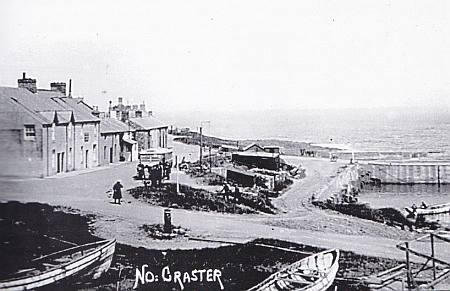
The only known photograph of Rutherford’s buses Craster, is this postcard taken in the late 1920s. The bus is thought to be a Gilford registration number CN 3496 or CN 3669. © R. C. Davis.
- S.E.Young had a licence to run between Tweedmouth and Spittal in 1923.
- Patterson of Heatherslaw was coming into Berwick from the Ford direction from 15th May 1923.
- Redfearn, Golden Square, Berwick bought a charabanc in this period. He ran local trips and a school contract well into the 1930s.
- Knox, from Amble.
- Rutherford, from Craster.
- John Turnbull, a Kelso haulier, started a service to Berwick in late 1922.
- George Henderson, Duns, started to run between Duns, Chirnside and Berwick on 1st August 1923. He went a little further when, that October, he advertised a special evening service from Duns to Berwick with reserved seats on both bus and cinema for Berwick Playhouse. Around that time he began another service between St. Abbs, Coldingham and Berwick. In October 1923 a new company was registered in Edinburgh to acquire Henderson’s business, the directors of which were G.Henderson and Harry Brook.
- Harry Brook began a bus service in Amble which he sold on to Knox. He went to Selkirk and opened a service to Galashiels. He expanded from there and joined with the Amos Brothers who had also set up in that area, the two forming Brook and Amos.
- Amos Bros ran their first package holiday in the summer of 1921. Two days from Selkirk to the Lake District – all inclusive, dinner, bed, breakfast – for £3/12/6. You went in a charabanc with solid tyres – the chara couldn’t take Kirkstone Pass – the passengers got out and walked. Still it was successful and such trips would be repeated.
Longer distance
AMOS, PROUD & CO were private operators from Choppington who worked in the Newcastle area but were growing in size. They obtained licences for a Newcastle-Berwick-Edinburgh service which began in August 1927, twice daily from each end and soon increased to two-hourly. In order to crew this service, staff were transferred from Choppington to Berwick.
The success of this initiative drew the rival attention of two of the large corporate bus companies. United Automobile Services Ltd had established itself in many parts of England and its operations included south Northumberland. None of its buses had so far run along the A1 north of Alnwick. SMT (Scottish Motor Traction) was a major Scottish firm whose services already included one between Edinburgh and Dunbar. United and SMT now collaborated to set up a joint Newcastle-Edinburgh service in 1928, and later in that year they were successful in their aim of buying out the competition from Amos & Proud. Some staff for the new service were recruited in Berwick and continued working for it until the 1970s.
Competition and the need for change
By the end of the 1920s, competition had intensified and legislation had failed to contain the questionable practices which some operators applied. Speed limits for buses were related to the weight of the bus: for a 30-seater the maximum speed allowed was 12mph; but a smaller and lighter bus could go at 20mph. Some operators would exploit this difference to run competitors off the road. There were few health and safety laws, and drivers’ hours were unregulated, leading to an increased danger of accidents through fatigue.
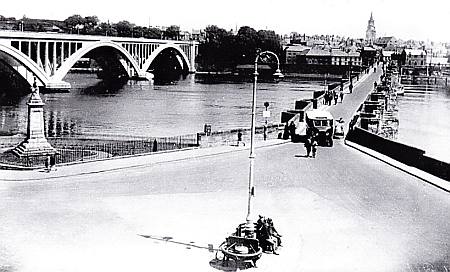
Pictured leaving the Berwick Bridge (locally known as the Old Bridge) at Tweedmouth, is Spowart’s bus on the way to Spittal. Looking pristine in the photograph is The Royal Tweed Bridge (locally known as the New Bridge) opened in 1928. This photograph is likely to have been circa 1928/29. © Fred Kennington.
The Road Traffic Act of 1930 removed the licensing of buses from local councils and transferred to newly created Traffic Commissioners for given areas, establishing stricter standard for vehicles and staff. It marked a death-knell for poorly-run bus companies and encouraged a process whereby many began to sell out to larger firms.
That didn’t happen immediately in Berwick where the local companies had kept their buses in good order. One significant change was the opening of the New Bridge in May 1928, which made access to the town by larger buses easier. Hitherto buses of all sizes had to use the Old Bridge together with all traffic and pedestrians. The Spittal via Old Bridge service was still busy and continued to run, but conditions were laid down restricting the bridge’s use to buses with no more than 14 seats.
Eventually the expansions of the larger companies like United and SMT could not be resisted, and in March 1934 the local Berwick operators of Thompson, Spowart, and John Young were taken over by United. (The Spittal via Old Bridge service was kept going until 1939 but then dropped.) For details of the buses used by private local bus operators (Spowart Brothers, Thompson Brothers, and J.W. Young) who were taken over by United Automobile Services on 4 March 1934, see this document (PDF). The coastal route from Alnwick to Berwick via Bamburgh was also bought from Rutherford of Craster, and purchases in the Wooler area allowed United to open a garage in Wooler. Simultaneously in the Borders, SMT had continued to buy out most of the independent companies, including the sizeable network of Brook & Amos which reached Berwick from Galashiels, Duns, Kelso, and St Abbs. On this basis, services settled down for a while.
WW2
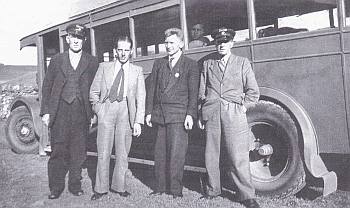
One of United’s buses requisitioned by the Army in 1940 to take troops to the costal defences. The buses were based at Ewart Park, Milfield where the drivers slept in them. This photograph was taken on a Sunday at Wooler when their families could visit them. From the left: Bob Blaikie, Jack Robson, Albert Todd and John Richardson from Berwick depot. © Fred Kennington.
When war broke out in September 1939, some services such as Spittal-Berwick via the Old Bridge were immediately withdrawn, and the time of the last buses was moved forward to 9pm. The blackout started at once and bus headlamps were covered, allowing only two peeps of light. Interior lights were dimmed and conductors used torches to see what they were doing. When conscription started it did not affect bus driving as it was a ‘reserved occupation’. The ‘invasion scare’ of 1940 led the army to requisition some buses and drivers from United at Berwick. The buses were repainted grey and sent to Ewart Park where troops were stationed. Troops were taken to anti-invasion defences at Budle Bay, Bamburgh and Embleton. The drivers had to stay with their buses and sleep in them; they were returned to Berwick once the ‘scare’ subsided. Buses were also used to take workmen to Brunton, Milfield, Winfield and Charterhall when those airfields were under construction.
Sometimes buses had to be lent elsewhere to make up for vehicles which had been lost in bombing raids; in October 1940 United lent London Transport fourteen elderly Bristol ‘B’ types and another seven went to Northern Ireland (to be returned by late 1941).
From 1941, to reduce fuel consumption, United had to convert some buses to use producer gas. They had to tow a trailer in which anthracite was burnt to produce the gas; the fire had to be lit every morning and put out on return. It required skill to keep the fire stoked up en route and maintain the gas supply, and not all drivers coped. Buses usually had about 35 seats, allowing 8 standing, but some had seats placed round the inside of the bus to allow 30 standing. Since there were few private cars, everybody had to use buses. Priority was given to essential workers.
In 1943 the service between Newcastle and Edinburgh was split at Berwick and timetabled in such a way as to to stop passengers making a through connection.
Post war
After the war the availability of buses was starting to be a problem, as well as their age. Few new buses had been built during the war, and engineering staff had to keep older buses in service as best they could. By 1947 some of the United buses had run 1,000,000 miles, and there was still a 1928 Bristol ‘B’ type and some very elderly AEC buses in service; these were not replaced until October 1949. In April 1949 the SMT company became Scottish Omnibuses.
Gradually pre-war timetables were re-established and some new services appeared.
- Newcastle-Edinburgh (direct): restored June 1946.
- Berwick-Edinburgh via Westruther: 1946 (SMT).
- Duns-Longfarmacus: 1946 (SMT)
- Services to Abbey St Bathans, Old Heaton, Pressen, Chatton, Quarry Corner and Prior Park: 1946.
- Berwick-Spittal (United) and Berwick-Highfields (SMT) linked to provide 15 minute service across town: 1947.
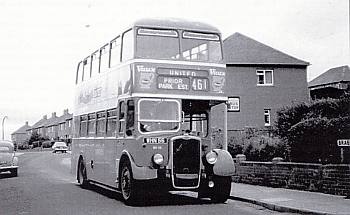
United operated their town services in the late 1960s with these Bristol KSW6Bs. Pictured in Braeside, Prior Park is a Bristol KSW6Bs, registration number WHN 56. © Fred Kennington.
By 1954 there were signs of declining passenger traffic. Private cars and petrol were more widely available, and the arrival of television was changing habits of going out in the evening for entertainment. Nevertheless some new services started in response to local circumstances:
- to Pringle’s factory, 1957;
- to Spittal Hall, 1965;
- to the Trading Estate, 1969.
By 1968 double-decker buses were in use (to Spittal, Prior Park, and Eyemouth). One-man operation was also introduced in Berwick to cut costs.
In 1972 the 477 service linking Berwick and Holy Island began, once the causeway had been completed by a bridge over the River Low; it operated to a tide table, not a timetable.
Deregulation of bus services
The Road Traffic Act of 1930 had brought order from ruthless competition in the early 1930s. That remained until in the 1980s a political decision was taken to ‘free’ bus operation and allow it to become competitive once again. A deregulated system was introduced in Scotland in 1985, and in England on 26th October 1986. Bus operators now had to ‘register’ the services they wished to run, and the scope of the Traffic Commissioners changed. The big companies had to be broken up: United’s operation in Northumberland became Northumbria Motor Services Ltd.
Competition flared, and in some urban areas for a while there were ‘wall-to-wall’ buses. Berwick had both green and red minibuses on town services at frequent intervals, but that could not be sustained and things eventually settled down. The ‘new’ companies would change hands periodically: the former United company became part of Arriva, and the former SMT became part of First Group.
One innovation introduced in Berwick under the new transport legislation was local services operated initially by 8 seater vehicles and later by minibuses. Taxibus, later Cross-Country Connexions, provided services to Wooler, Eyemouth, and later to Edinburgh.
History repeats itself
In the late 1920s almost all bus services were run by private operators – Thompson, Spowart, Young, etc. By 2016 the ‘big’ corporate operators had vanished, and buses were again in the hands of smaller private companies, notably Perryman’s. Then in 2017 came more change – with Perryman’s operation passed to Border Buses, owned by West Coast Motors.
And now… along comes the ‘Berwick Hoppa’ running minibuses across the Old Bridge – for the first time since September 1939.
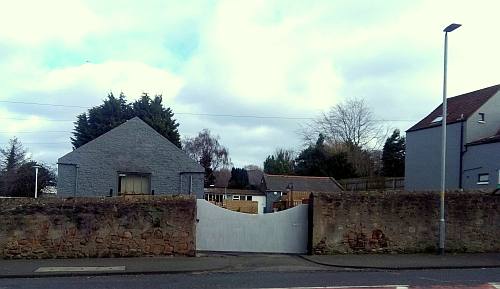
The Highgate Works in Main Street, Tweedmouth, where F. G. Pickering’s automotive production took place at the beginning of the 20th century. The building was later occupied by A. C. Burn, agricultural supplies, retaining the name ‘Highgate Works’ in their address. Currently it has a new use as a music venue. Photograph © Kevin Graham, 2020.
Berwick’s early bus builder
The beginning of the 20th century was an evolutionary period for public transport, in the form of trams, trolleybuses, buses and railways, which all had their UK centres of manufacturing. Surprisingly, Berwick-upon-Tweed nearly became one of those centres in 1905, in the form of bus manufacturing at F. G. Pickering in Tweedmouth.
Frederick George Pickering of Tweedmouth established himself as bus manufacturer around 1905, and supplied a number of buses to the Italian government. In 1906 he also produced buses for the Penrith and District Motor Services Company Ltd. In an early advert for the company Pickering stated that he had “put down new plant for the production of motor cars and cycles” and he would “give estimates for any class of motor car or cycle, also motor haulage wagons”. This showed the versatility of Pickering’s business at his Highgate Works in Tweedmouth.
Pickering was born in Carlisle in 1872, and he married Christine Hope Tait of Tweedmouth in 1903. For the full fascinating story of this talented engineer, and his company’s early entry into automotive production, click this link (PDF).
A note on Berwick’s Bus Station
From the end of WW1 attempts were made to address the bad state of housing in the town. The opening of the New Bridge in 1928 encouraged the Council to build new houses in Tweedmouth, and in October 1934 the North Road Housing Scheme got under way. Highfields Estate (colloquially known as “Abyssinia”) was completed before WW2, with an SMT bus service added as it developed. In the town centre slum property remained a problem and clearances began in Walkergate, Chapel Street and Weatherley Square.
Most buses stopped in the High Street, and traffic congestion was creating demand for a bus station to relieve the pressure. The clearance of Weatherley Square etc. gave the opportunity for a bus station on that site, and in 1935 SMT bought some of the land to build the garage and station (in a joint arrangement with United). The station was in use in 1937 with SMT using the rear entrance in Chapel Street. For many years a wallpaper shop stood on an island in isolation at the bottom of the Bus Station, creating an entrance and exit; it remained until the lease expired and was then demolished.
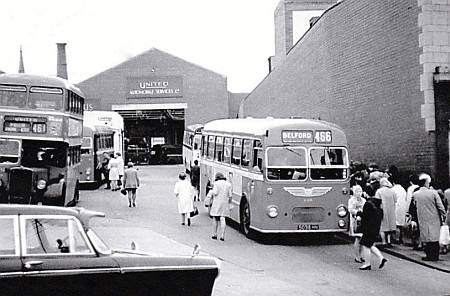
Berwick Bus Station photographed in October 1968, a heyday period for bus transportation in Berwick and the surrounding area. © Fred Kennington.
In the years before the bus station and garage, buses had been garaged in various places. Spowart – on Berwick’s Quayside.
United – Boston’s fish yard, Spittal; A&B Garage, Silver Street; (plus office at 17 West Street); also John Young’s garage, Norham.
SMT – Boston’s fish yard,Spittal; Chisam’s Garage, Castlegate.
The demise of the bus station
By 1994 the structural condition of the buildings of the bus station, still owned by the successors to United and SMT, was in doubt. Both operators moved their buses out of the garages to the MOT Testing Site at Ord Road in February 1996, and work to demolish the bus station began in the late spring of 1998. The main bus terminus was moved to the top of Crawford’s Alley, off Chapel Street, which was generally deemed inconvenient to bus drivers, passengers and local businesses. The idea of an Interchange at the station was mooted but did not come to fruition. Eventually services settled down with Newcastle and other southbound services terminating at the Station, northbound services stopping in Tweedmouth, and others in Chapel Street.
Buses garaged on Ord Road were moved to the Furst Garage at Scremerston in September 1998. After a period of uncertainty about the future of Arriva’s town bus services, the company decided to withdraw them. and their Berwick depot closed in October 2002. Perrymans took over their services two days later, while Arriva continued to operate services to Alnwick and Newcastle from other depots.
Veterans cruise by bus to Selkirk
The amusing report below describes the bus trip of a group veteran fishermen from Eyemouth to Selkirk, appeared in The Berwickshire News, on Tuesday 28th June 1927.
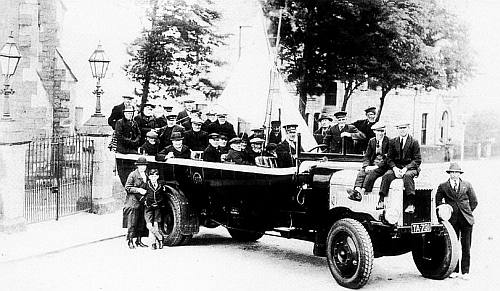
Brook & Amos’s Leyland charabanc, registration number TA 731, with the group of veteran fishermen from Eyemouth, taken in Selkirk, in June 1927. The bus dates from 1921. © Fred Kennington.
Eyemouth Old Fishermen’s Picnic
On Tuesday last, the fourth year in succession, the old fishermen of Eyemouth enjoyed their annual “Land Cruise.” At 8 a.m. 23 veterans met at the Weatherglass and boarded a special motor bus rigged out in full as a sailing yacht. The life-experienced crew was skippered for the voyage by Mr Thos. Fairbairn, and they had a good send off by a large number of spectators. A gale of wind was blowing but that was of no account to men who had faced gales of wind under worse conditions, so with all sails set the motor-bus-sailing-yacht weighed anchor and steered for the open with Selkirk as the main port of call. About 7 miles out the fury of the gale increased and the skipper ordered a ‘reef’ to be taken in, and a few miles further on he was compelled to order both sails to be hauled to the deck to avoid disaster. The time was pleasantly passed with songs and jokes.
On reaching Gordon Hospital, a halt was made to make inquiries regarding a small boy from Eyemouth who was lying ill there. We must not forget to say that although sails had to be hauled down from stress of weather, they were always hoisted when within sight of human habitation, and the Land Ship passed through towns and villages in all the glory of “Full Sail.” Galashiels was reached about noon, when both the boat and crew were supplied with “petrol.”
The Skipper at last cast anchor at the port of the “Queen’s Head,” Selkirk, at 1 p.m., and there Mr A. Munro, the officer-in-charge, most hospitably received the company. An adjournment was then made to the hall where the hungry yachtsmen were well entertained and regaled with an excellent repast.
Mr. Edwards, Photographer, Selkirk, took photographs of the “Ancient Mariners” and their “Motor-ship.” The company then drove slowly round about Selkirk until 4 p.m., when the Manager of the Picture Place gave them a free exhibition, including the pictures of the Common Riding. During the exhibition the Inspector of Police kept a fatherly eye on the Mariners. Tea was served at 5 p.m., after which an impromptu concert was held of which the programme was Song. ‘The Beggar Man,’ by Mr W. Landles (Butler); encore, ‘Robin Tamson’s Smiddy oh’; song ‘Flora McDonald’s Lament.’ Mr D. Collin (Sailor); encore. ‘Scottish Emigrants’ Farewell’ recitation, ‘His One Hair,’ Mr A. Munro, Selkirk; song, ‘I’m a Young Rovin’ Laddie,’ Mr James Burgon (Curly), encored.
At this point the excitement grew great, and each vied with the other in his desire to assist in the programme so that it was brought to a conclusion by a special request from Mr Munro for the song ‘Brannan on the Moor,’ by Mr D. Collin.
Preparations were then made for the homeward journey via Bemersyde, Leaderfoot Bridge and Duns. Mr Munro accompanying the party in his own motor car as far as the Bridge, where he bade them a goodbye to the strains of ‘He’s a Jolly Good Fellow.’ With sails set and lights shown, Eyemouth was reached about 10.15 p.m., and a large crowd welcomed the return of the voyagers. Before parting Mr Jas. Lough thanked all subscribers on behalf of the veterans, also Messrs R. Paterson and D. S. Dougal, who organised the trip. Among the subscribers outside Eyemouth should be mentioned Messrs R. Hastie and Sons, North Shields; Messrs Irvin and Son, North Shields; Messrs Suffling, Yarmouth; Mr Sydney Smith, North Shields.
The sum of £17 was collected and expenses for the day amounted approximately to £15 15s. so that a small balance is left in reserve for next year.
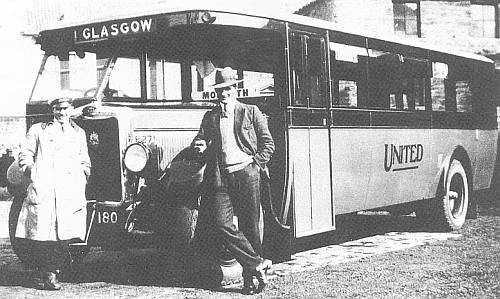
United’s Leyland Tiger B271, registration number VF 4180 (renumbered AT38 in 1930). This photograph was taken at Berwick Quayside before the bus was delivered to the United depot in Berwick. Pictured in the photograph is driver Tommy Miller with Mr Burn the Area Engineer. © Fred Kennington.
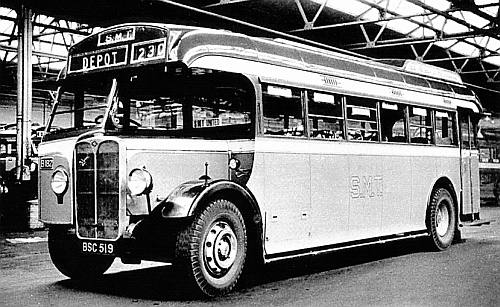
SMT’s AEC Regal B182 in New Street, Edinburgh after its arrival from Berwick. Its sister vehicle AEC Regal B181, worked the Berwick to Spittal route for a number of years. It is of 1934 vintage with an Alexander body. © R Grieves.
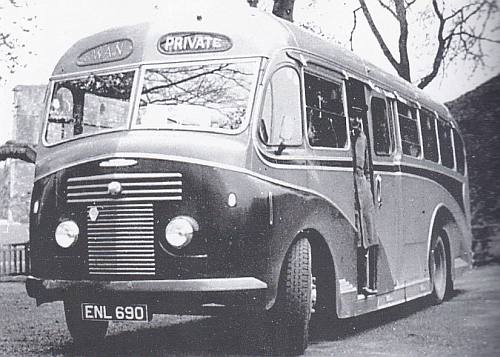
Ralph Swan stands on the step of the Commer Avenger with which he set up business in 1950. His private hire was visiting Norham Castle. © Fred Kennington.
Source:
Fred Kennington. Travellers’ Tales from the Borders. (Stockport, 2000.)
Fred Kennington has also written about the names given to many varieties of local transport in It’s all in the name (2021).

